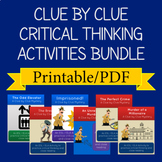A Suprise for the Boss: Critical Thinking Mystery Activity
- PDF
Also included in
- By popular demand, all my clue by clue mysteries PDF (printable) format in one big bundle, plus a free mystery story organizing worksheet. Be sure to check the list above to see the exact list of Clue by Clue Mysteries!Each individual mystery is in PDF format and contains:A cover imageComprehensivePrice $90.00Original Price $123.00Save $33.00
Description
In this mystery activity that encourages discussion and critical thinking, the CEO of a company invites some employees to his birthday party. During the party, a statue from his art collection goes missing. Who did it and why? Can your students use their reading strategies, critical thinking, and logical reasoning to analyze the evidence and figure it out?
This is a printable PDF edition designed to be used in the classroom for pairwork or in small groups. However, it can also be adapted for individual work or worked through with the whole class. Designed for middle grade or high school students, this activity has also been used with college and university students, or even young adults.
What is a Clue by Clue Mystery?
A great warm-up, critical thinking game, conversation starter, filler, or a time killer for early finishers. Students in pairs or small groups are given a short mystery to solve—whodunit or how did they do it or why. They have to figure it out by reading a series of clues, one at a time. As they receive each clue, they speculate on its significance, what it tells them about the situation, and how it fits with the previous clues.
Once they have received all the clues, they have enough information to figure it out! This one will definitely get your students talking!
Inside find:
- Teacher Notes on how to use the clues, including suggested warm-ups.
- 10 clues to be given to students one by one.
- Hints in the form of guiding questions to help students figure out what happened.
- The Solution: Students are not left hanging. There is a clear solution that follows from the clues. No gimmicks, no tricks, no need to know obscure facts.
Why Use Clue by Clues?
Clue by Clues encourage critical thinking and discussion. They are also close reading activities that teach students to look for details, synthesize information from different sources, apply prior knowledge about the world, and to recognize the logic of a claim and evaluate its validity.
While students are solving the mysteries, they are also developing their spoken language skills, using language such as:
- Modal verbs of speculation: She must have forgotten her keys, It could have been the butler
- Opinion language: I think...., I’m positive..., I’m not sure...
- Hedging: It’s possible, probably, maybe, it’s not impossible.
- Conclusions: That means that...
- Emphasis: There’s no way that...
- Hypotheticals: What if he didn’t do it, If he was at the movies, he couldn’t have done it.
They are also a lot of fun!
Enjoy this? Check out my entire Mystery Section with more clue by clues in different formats. I also have activities to help students write their own mysteries and more!
And please leave a review. It helps others find this resource and gives me valuable feedback when creating new ones!






